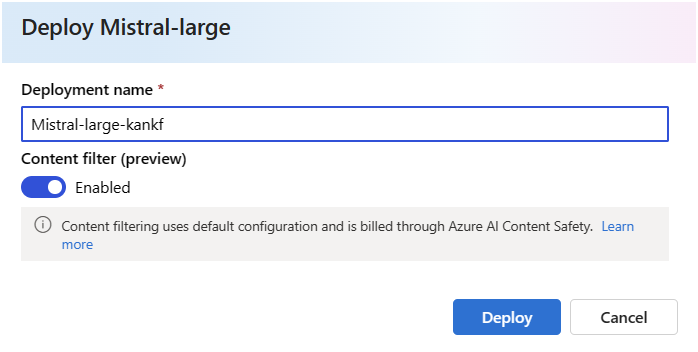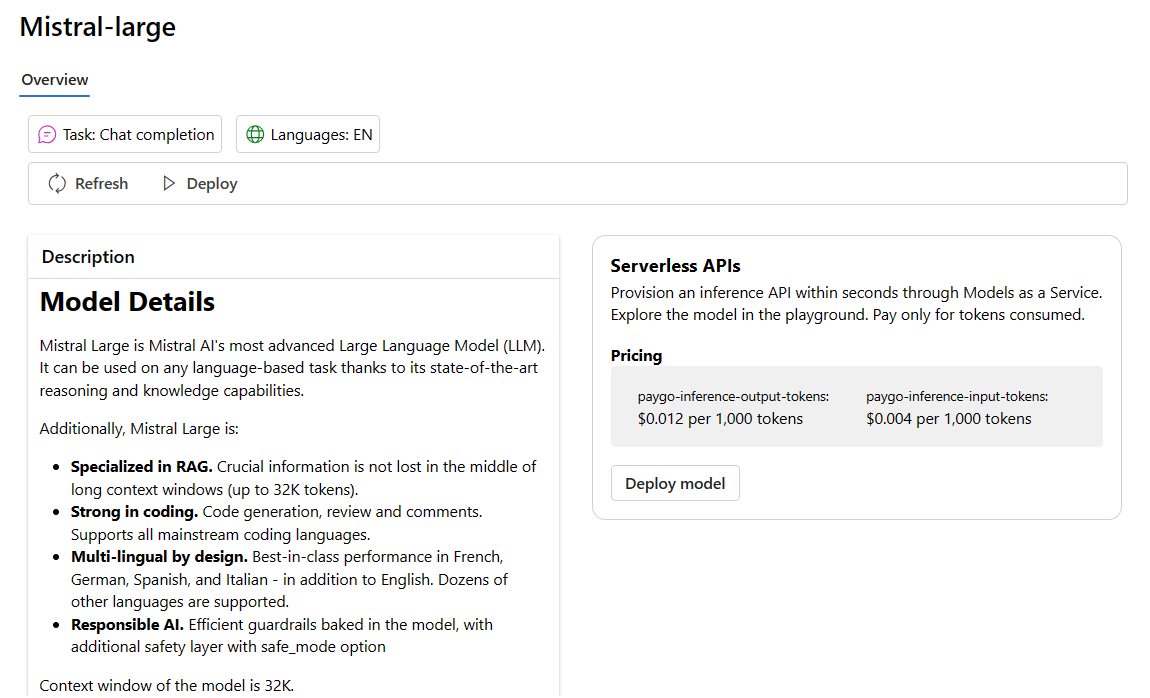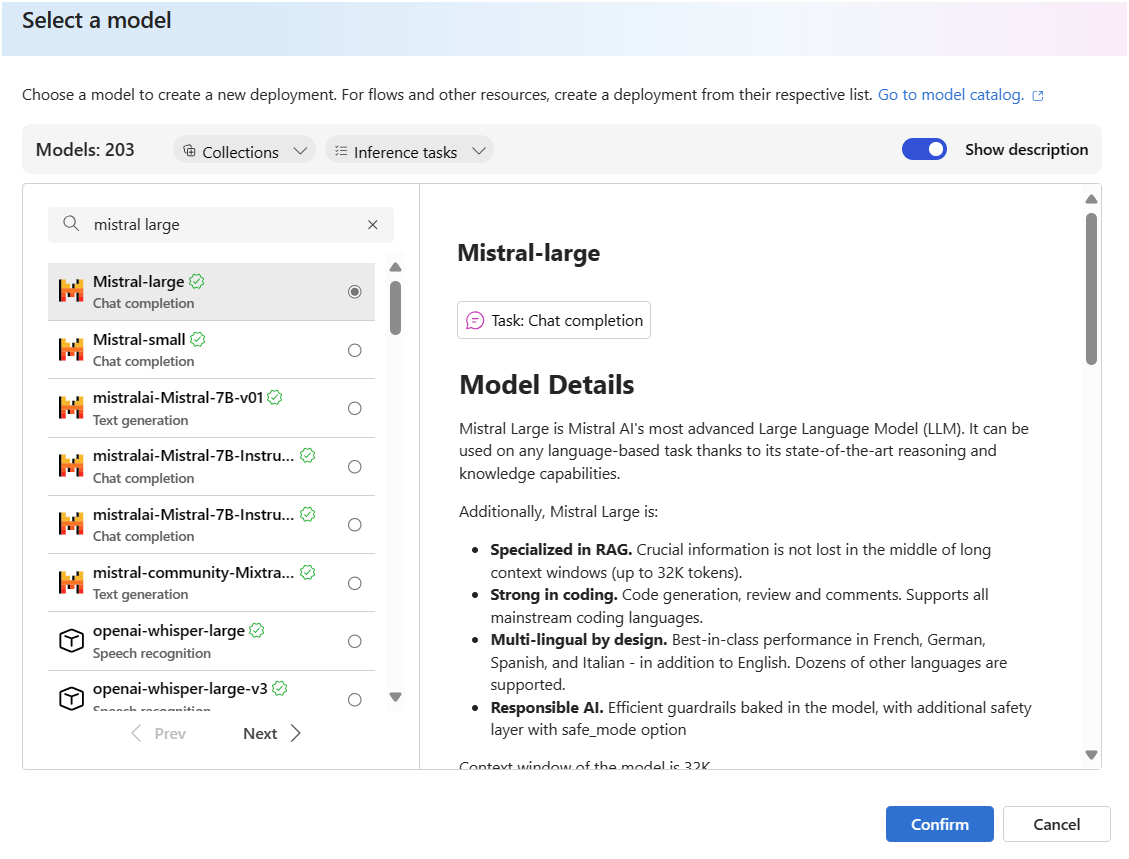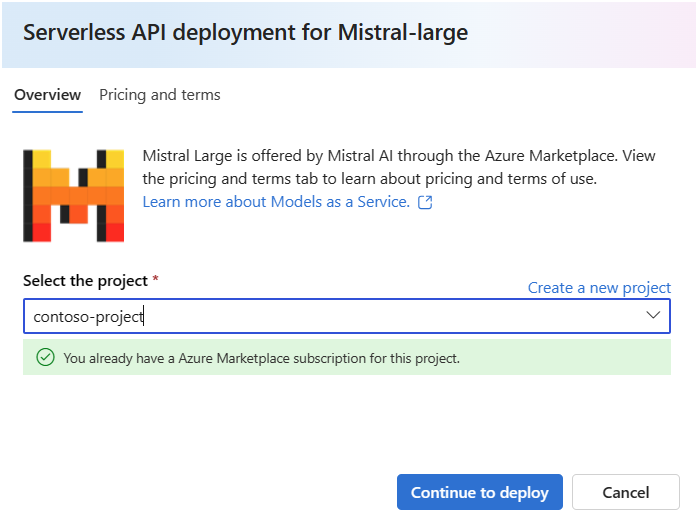How to deploy Mistral models with Azure AI Studio
Important
Some of the features described in this article might only be available in preview. This preview is provided without a service-level agreement, and we don't recommend it for production workloads. Certain features might not be supported or might have constrained capabilities. For more information, see Supplemental Terms of Use for Microsoft Azure Previews.
In this article, you learn how to use Azure AI Studio to deploy the Mistral family of models as serverless APIs with pay-as-you-go token-based billing. Mistral AI offers two categories of models in the Azure AI Studio. These models are available in the model catalog:
- Premium models: Mistral Large and Mistral Small. These models can be deployed as serverless APIs with pay-as-you-go token-based billing.
- Open models: Mixtral-8x7B-Instruct-v01, Mixtral-8x7B-v01, Mistral-7B-Instruct-v01, and Mistral-7B-v01. These models can be deployed to managed computes in your own Azure subscription.
You can browse the Mistral family of models in the model catalog by filtering on the Mistral collection.
Mistral family of models
Mistral Large is Mistral AI's most advanced Large Language Model (LLM). It can be used on any language-based task, thanks to its state-of-the-art reasoning and knowledge capabilities.
Additionally, Mistral Large is:
- Specialized in RAG. Crucial information isn't lost in the middle of long context windows (up to 32-K tokens).
- Strong in coding. Code generation, review, and comments. Supports all mainstream coding languages.
- Multi-lingual by design. Best-in-class performance in French, German, Spanish, Italian, and English. Dozens of other languages are supported.
- Responsible AI compliant. Efficient guardrails baked in the model and extra safety layer with the
safe_modeoption.
Deploy Mistral family of models as a serverless API
Certain models in the model catalog can be deployed as a serverless API with pay-as-you-go billing. This kind of deployment provides a way to consume models as an API without hosting them on your subscription, while keeping the enterprise security and compliance that organizations need. This deployment option doesn't require quota from your subscription.
Mistral Large and Mistral Small can be deployed as a serverless API with pay-as-you-go billing and are offered by Mistral AI through the Microsoft Azure Marketplace. Mistral AI can change or update the terms of use and pricing of these models.
Prerequisites
An Azure subscription with a valid payment method. Free or trial Azure subscriptions won't work. If you don't have an Azure subscription, create a paid Azure account to begin.
An AI Studio hub. The serverless API model deployment offering for eligible models in the Mistral family is only available with hubs created in these regions:
- East US
- East US 2
- North Central US
- South Central US
- West US
- West US 3
- Sweden Central
For a list of regions that are available for each of the models supporting serverless API endpoint deployments, see Region availability for models in serverless API endpoints.
Azure role-based access controls (Azure RBAC) are used to grant access to operations in Azure AI Studio. To perform the steps in this article, your user account must be assigned the Azure AI Developer role on the resource group. For more information on permissions, see Role-based access control in Azure AI Studio.
Create a new deployment
The following steps demonstrate the deployment of Mistral Large, but you can use the same steps to deploy Mistral Small by replacing the model name.
To create a deployment:
Sign in to Azure AI Studio.
Select Model catalog from the left sidebar.
Search for and select Mistral-large to open its Details page.
Select Deploy to open a serverless API deployment window for the model.
Alternatively, you can initiate a deployment by starting from your project in AI Studio.
From the left sidebar of your project, select Components > Deployments.
Select + Create deployment.
Search for and select Mistral-large. to open the Model's Details page.
Select Confirm to open a serverless API deployment window for the model.
Select the project in which you want to deploy your model. To use the serverless API model deployment offering, your project must belong to one of the regions listed in the prerequisites.
In the deployment wizard, select the link to Azure Marketplace Terms to learn more about the terms of use.
Select the Pricing and terms tab to learn about pricing for the selected model.
Select the Subscribe and Deploy button. If this is your first time deploying the model in the project, you have to subscribe your project for the particular offering. This step requires that your account has the Azure AI Developer role permissions on the resource group, as listed in the prerequisites. Each project has its own subscription to the particular Azure Marketplace offering of the model, which allows you to control and monitor spending. Currently, you can have only one deployment for each model within a project.
Once you subscribe the project for the particular Azure Marketplace offering, subsequent deployments of the same offering in the same project don't require subscribing again. If this scenario applies to you, there's a Continue to deploy option to select.
Give the deployment a name. This name becomes part of the deployment API URL. This URL must be unique in each Azure region.

Select Deploy. Wait until the deployment is ready and you're redirected to the Deployments page.
Select Open in playground to start interacting with the model.
Return to the Deployments page, select the deployment, and note the endpoint's Target URL and the Secret Key. For more information on using the APIs, see the reference section.
You can always find the endpoint's details, URL, and access keys by navigating to your Project overview page. Then, from the left sidebar of your project, select Components > Deployments.
To learn about billing for the Mistral AI model deployed as a serverless API with pay-as-you-go token-based billing, see Cost and quota considerations for Mistral family of models deployed as a service.
Consume the Mistral family of models as a service
You can consume Mistral family models by using the chat API.
From your Project overview page, go to the left sidebar and select Components > Deployments.
Find and select the deployment you created.
Copy the Target URL and the Key value.
Make an API request using to either the Azure AI Model Inference API on the route
/chat/completionsand the native Mistral Chat API on/v1/chat/completions.
For more information on using the APIs, see the reference section.
Reference for Mistral family of models deployed as a service
Mistral models accept both the Azure AI Model Inference API on the route /chat/completions and the native Mistral Chat API on /v1/chat/completions.
Azure AI Model Inference API
The Azure AI Model Inference API schema can be found in the reference for Chat Completions article and an OpenAPI specification can be obtained from the endpoint itself.
Mistral Chat API
Use the method POST to send the request to the /v1/chat/completions route:
Request
POST /v1/chat/completions HTTP/1.1
Host: <DEPLOYMENT_URI>
Authorization: Bearer <TOKEN>
Content-type: application/json
Request schema
Payload is a JSON formatted string containing the following parameters:
| Key | Type | Default | Description |
|---|---|---|---|
messages |
string |
No default. This value must be specified. | The message or history of messages to use to prompt the model. |
stream |
boolean |
False |
Streaming allows the generated tokens to be sent as data-only server-sent events whenever they become available. |
max_tokens |
integer |
8192 |
The maximum number of tokens to generate in the completion. The token count of your prompt plus max_tokens can't exceed the model's context length. |
top_p |
float |
1 |
An alternative to sampling with temperature, called nucleus sampling, where the model considers the results of the tokens with top_p probability mass. So 0.1 means only the tokens comprising the top 10% probability mass are considered. We generally recommend altering top_p or temperature, but not both. |
temperature |
float |
1 |
The sampling temperature to use, between 0 and 2. Higher values mean the model samples more broadly the distribution of tokens. Zero means greedy sampling. We recommend altering this parameter or top_p, but not both. |
ignore_eos |
boolean |
False |
Whether to ignore the EOS token and continue generating tokens after the EOS token is generated. |
safe_prompt |
boolean |
False |
Whether to inject a safety prompt before all conversations. |
The messages object has the following fields:
| Key | Type | Value |
|---|---|---|
content |
string |
The contents of the message. Content is required for all messages. |
role |
string |
The role of the message's author. One of system, user, or assistant. |
Request example
Body
{
"messages":
[
{
"role": "system",
"content": "You are a helpful assistant that translates English to Italian."
},
{
"role": "user",
"content": "Translate the following sentence from English to Italian: I love programming."
}
],
"temperature": 0.8,
"max_tokens": 512,
}
Response schema
The response payload is a dictionary with the following fields:
| Key | Type | Description |
|---|---|---|
id |
string |
A unique identifier for the completion. |
choices |
array |
The list of completion choices the model generated for the input messages. |
created |
integer |
The Unix timestamp (in seconds) of when the completion was created. |
model |
string |
The model_id used for completion. |
object |
string |
The object type, which is always chat.completion. |
usage |
object |
Usage statistics for the completion request. |
Tip
In the streaming mode, for each chunk of response, finish_reason is always null, except from the last one which is terminated by a payload [DONE]. In each choices object, the key for messages is changed by delta.
The choices object is a dictionary with the following fields:
| Key | Type | Description |
|---|---|---|
index |
integer |
Choice index. When best_of > 1, the index in this array might not be in order and might not be 0 to n-1. |
messages or delta |
string |
Chat completion result in messages object. When streaming mode is used, delta key is used. |
finish_reason |
string |
The reason the model stopped generating tokens: - stop: model hit a natural stop point or a provided stop sequence. - length: if max number of tokens have been reached. - content_filter: When RAI moderates and CMP forces moderation - content_filter_error: an error during moderation and wasn't able to make decision on the response - null: API response still in progress or incomplete. |
logprobs |
object |
The log probabilities of the generated tokens in the output text. |
The usage object is a dictionary with the following fields:
| Key | Type | Value |
|---|---|---|
prompt_tokens |
integer |
Number of tokens in the prompt. |
completion_tokens |
integer |
Number of tokens generated in the completion. |
total_tokens |
integer |
Total tokens. |
The logprobs object is a dictionary with the following fields:
| Key | Type | Value |
|---|---|---|
text_offsets |
array of integers |
The position or index of each token in the completion output. |
token_logprobs |
array of float |
Selected logprobs from dictionary in top_logprobs array. |
tokens |
array of string |
Selected tokens. |
top_logprobs |
array of dictionary |
Array of dictionary. In each dictionary, the key is the token and the value is the probability. |
Response example
The following JSON is an example response:
{
"id": "12345678-1234-1234-1234-abcdefghijkl",
"object": "chat.completion",
"created": 2012359,
"model": "",
"choices": [
{
"index": 0,
"finish_reason": "stop",
"message": {
"role": "assistant",
"content": "Sure, I\'d be happy to help! The translation of ""I love programming"" from English to Italian is:\n\n""Amo la programmazione.""\n\nHere\'s a breakdown of the translation:\n\n* ""I love"" in English becomes ""Amo"" in Italian.\n* ""programming"" in English becomes ""la programmazione"" in Italian.\n\nI hope that helps! Let me know if you have any other sentences you\'d like me to translate."
}
}
],
"usage": {
"prompt_tokens": 10,
"total_tokens": 40,
"completion_tokens": 30
}
}
More inference examples
| Sample Type | Sample Notebook |
|---|---|
| CLI using CURL and Python web requests | webrequests.ipynb |
| OpenAI SDK (experimental) | openaisdk.ipynb |
| LangChain | langchain.ipynb |
| Mistral AI | mistralai.ipynb |
| LiteLLM | litellm.ipynb |
Cost and quotas
Cost and quota considerations for Mistral family of models deployed as a service
Mistral models deployed as a serverless API are offered by Mistral AI through the Azure Marketplace and integrated with Azure AI Studio for use. You can find the Azure Marketplace pricing when deploying the model.
Each time a project subscribes to a given offer from the Azure Marketplace, a new resource is created to track the costs associated with its consumption. The same resource is used to track costs associated with inference; however, multiple meters are available to track each scenario independently.
For more information on how to track costs, see monitor costs for models offered throughout the Azure Marketplace.
Quota is managed per deployment. Each deployment has a rate limit of 200,000 tokens per minute and 1,000 API requests per minute. However, we currently limit one deployment per model per project. Contact Microsoft Azure Support if the current rate limits aren't sufficient for your scenarios.
Content filtering
Models deployed as a serverless API with pay-as-you-go billing are protected by Azure AI Content Safety. With Azure AI content safety, both the prompt and completion pass through an ensemble of classification models aimed at detecting and preventing the output of harmful content. The content filtering system detects and takes action on specific categories of potentially harmful content in both input prompts and output completions. Learn more about content filtering here.
Related content
Feedback
Coming soon: Throughout 2024 we will be phasing out GitHub Issues as the feedback mechanism for content and replacing it with a new feedback system. For more information see: https://aka.ms/ContentUserFeedback.
Submit and view feedback for



